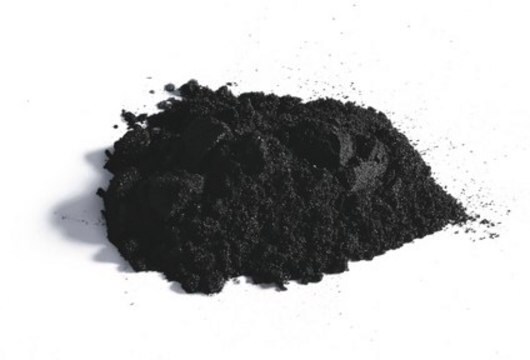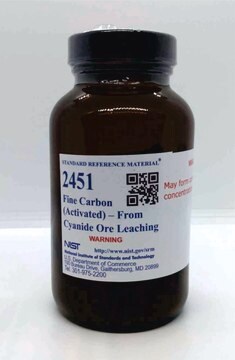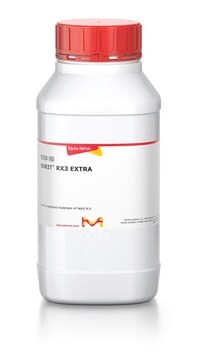1.02514
Aktivkohle
granular about 1.5 mm extra pure
Synonym(e):
Aktivkohle
About This Item
Empfohlene Produkte
Qualitätsniveau
Form
granular
Oberflächenbereich
800-1500 m2/g
Verunreinigungen
cyano compounds (CN), passes test
polycyclic aromates, passes test
tar, passes test
≤5% HNO3 solubles
≤5% Substances soluble in nitric acid
Glührückstand
≤10% (600 °C)
Verlust
≤10% loss on drying
Partikelgröße
1.5 mm
mp (Schmelzpunkt)
3550 °C
Schüttdichte
150‑440 kg/m3
Anionenspuren
chloride (Cl-): ≤1000 ppm
Kationenspuren
As: ≤5 ppm
Fe: ≤500 ppm
Pb: ≤20 ppm
Zn: ≤100 ppm
Lagertemp.
no temp limit
InChI
1S/C
InChIKey
OKTJSMMVPCPJKN-UHFFFAOYSA-N
Anwendung
- Adsorptive Entfernung von Farbstoffen und Verunreinigungen: Aktivkohle wird in großem Umfang für die Adsorption und Entfernung von Farbstoffen und anderen Verunreinigungen aus wässrigen Lösungen verwendet. Jüngste Forschungen zeigen, dass Aktivkohle, die mit BaFe12O19-Pulver modifiziert wurde, zur effizienten Entfernung von Methylblau-Farbstoff eingesetzt wird. Dieses magnetische Adsorptionsmittel kann leicht zurückgewonnen und wiederverwendet werden, was es zu einer nachhaltigen Option für die Wasseraufbereitung macht (Polley und Bera, International Journal of Environmental Analytical Chemistry, 2023).
- Nachweis und Beseitigung von Schwermetallen: Aktivkohle wird in Verbundmaterialien zum Nachweis und zur Entfernung von Schwermetallen aus Wasser verwendet. In einer bemerkenswerten Studie wurde ein Ni-Sensor auf der Grundlage von Aktivkohle-Kunststoffmembranen entwickelt, der die Wirksamkeit dieses Materials bei analytischen Anwendungen für die Umweltüberwachung und die Kontrolle der Umweltverschmutzung unter Beweis stellt (Zareh et al., Journal of Analytical Chemistry, 2022).
- Filterverbundwerkstoffe für die industrielle Abwasserbehandlung: Aktivkohle in Kombination mit Nanokristallen aus Zellulose des Bananen-Fruchtstiels wurde zur Herstellung von Filterverbundwerkstoffen für die Behandlung von Industrieabwässern verwendet. Diese Verbundstoffe entfernen wirksam Farbstoffe und Schwermetalle, was ihr Potenzial für groß angelegte Umweltanwendungen und die Verbesserung der Wasserqualität unter Beweis stellt (Rahman et al., International Journal of Environmental Analytical Chemistry, 2022).
- Zahnmedizinische Anwendungen: In der zahnmedizinischen Forschung wurde die Wirkung von Aktivkohle in Kombination mit Calciumhydroxid auf die Mikrohärte des Dentins untersucht. Diese Kombination ist vielversprechend für zahnmedizinische Behandlungen, insbesondere für die Verbesserung der mechanischen Eigenschaften von Dentin, und bietet potenzielle Vorteile in der restaurativen Zahnmedizin (Abdel Hamid, Egyptian Dental Journal, 2023).
- Umweltadsorptionsmittel und -sensoren: Aktivkohle wird auch zur Herstellung fortschrittlicher Umweltadsorptionsmittel und -sensoren verwendet. So konzentrierte sich eine Studie auf die Entwicklung von magnetisch rückgewinnbaren BaFe12O19-Aktivkohle-Chitosan-Kompositpulvern für die Adsorption von Methylblau-Farbstoff. Diese Materialien zeichnen sich durch hohe Effizienz, Wiederverwendbarkeit und einfache Rückgewinnung aus und sind daher ideal für Umweltsanierungsanwendungen (Polley und Bera, International Journal of Environmental Analytical Chemistry, 2022).
Hinweis zur Analyse
In Salpetersäure unlösliche Anteile: ≤ 5 %
Chlorid (Cl): ≤ 1000 ppm
Cyanverbindungen (CN): entspricht
As (Arsen): ≤ 5 ppm
Fe (Eisen): ≤ 500 ppm
Pb (Blei): ≤ 20 ppm
Zn (Zink): ≤ 100 ppm
Polyzyklische Aromaten: entspricht
Teerprodukte: entspricht
n-Hexan-Adsorption: ≥ 30 %
Glührückstand (600 °C): ≤ 10 %
Trocknungsverlust: ≤ 10 %
Lagerklassenschlüssel
11 - Combustible Solids
WGK
nwg
Analysenzertifikate (COA)
Suchen Sie nach Analysenzertifikate (COA), indem Sie die Lot-/Chargennummer des Produkts eingeben. Lot- und Chargennummern sind auf dem Produktetikett hinter den Wörtern ‘Lot’ oder ‘Batch’ (Lot oder Charge) zu finden.
Besitzen Sie dieses Produkt bereits?
In der Dokumentenbibliothek finden Sie die Dokumentation zu den Produkten, die Sie kürzlich erworben haben.
Kunden haben sich ebenfalls angesehen
Unser Team von Wissenschaftlern verfügt über Erfahrung in allen Forschungsbereichen einschließlich Life Science, Materialwissenschaften, chemischer Synthese, Chromatographie, Analytik und vielen mehr..
Setzen Sie sich mit dem technischen Dienst in Verbindung.




